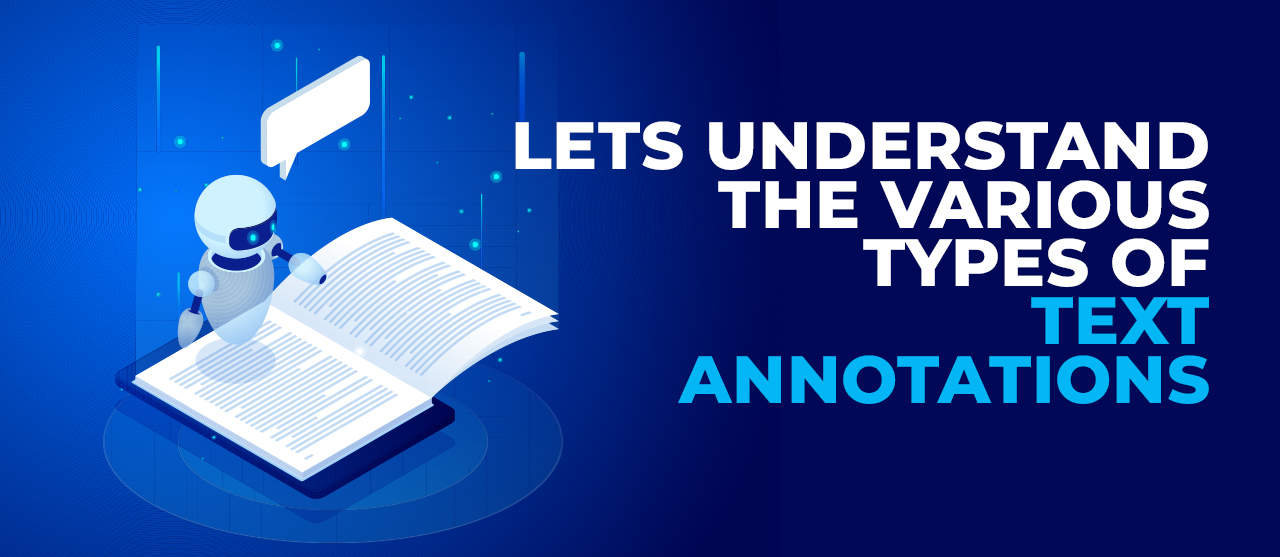
Have you ever wondered how your smartphone predicts what you want to type beforehand? That is NLP at work. ML models are trained to detect human emotions and language, perform better, and serve better. But these models need to be trained on high-quality data. And that’s where text annotation comes into the picture.
What Is Text Annotation?
Text annotation is when sentence structures are annotated or highlighted per specific criteria (based on the use case) to organize datasets. These datasets are used to train ML models to identify the human language, emotion, or intent behind the words.
Why Do You Need Text Annotation?
Human language is inherently complex to understand. At times, even humans fail to accurately comprehend the intent or sentiment behind spoken or written words. Enter text annotation. Text annotation is essential as it helps the machine learning models correctly detect the various meanings behind the data in textual, audio, or even video format.
For instance, in the below example –
Dear Raj,
Today, I saw deer in the zoo.
An ML model would segregate the above text into – intent, entity, linguistic, and sentiment.
Text Annotations – Understanding The Types
There are essentially five types of text annotations techniques –
-
Sentiment Annotation
This type of text annotation technique deals with human sentiments in the language—for instance, wit, sarcasm, negative, and positive.
-
Linguistic Annotation
Linguistic annotation involves the identification of phonetics or semantic elements, as well as grammatical elements in the data that are either in the text or in the audio format. There are essentially three types of linguistic annotations: discourse, phonetic, and semantic annotation.
-
Intent Annotation
With this annotation, the annotator wants to segregate the intent of the writer and speaker, especially when interacting with chatbots. You must have come across bots that incorrectly interpreted and answered your complex question on eCommerce sites. In the background, it means that the bot is not correctly annotated to understand the intent.
-
Entity Annotation
It helps identify the correct entity in the text. For instance: Paris Hilton is an American heiress. The task here would be to determine that Paris is not the city, and Hilton is not the hotel here but a person’s name. Entity annotation is further segregated into – essential phrase tagging, named entity recognition, and parts of speech annotation.
-
Text Classification
This is a process where the entire body of the text is annotated and characterized under labels like product categorization, sentiment analysis, and document classification.
Let’s explore each of these in more detail.
1) Sentiment Annotation
Detecting sentiments in a language is no easy task, especially if there is a hint of wit, sarcasm, or any other form of informal communication. This is where sentiment annotation of the textual data comes to help. You will hear the more used terms like opinion mining or sentiment analysis for sentiment annotation. Both are the same thing.
The given data is analyzed and labeled depending on the closest emotion possible. For example, customer reviews in an eCommerce store, where the responses can be neutral, negative, or positive.
2) Linguistic Annotation
In linguistic annotation, the annotator must tag the linguistic data in both text and audio recordings. The job of an annotator is to identify semantic or phonetic, or grammatical elements in the textual or audio data. Linguistic annotation is segregated into four types:
- Discourse Annotation: This is where anaphors and cataphors are linked to their antecedent or precedent topics. For instance: Julia broke the doll. She felt terrible about it.
- Parts of Speech Tagging: This refers to annotating the various function words in textual data.
- Phonetic Annotation: This is where the annotator labels the stress, natural pauses, and intonation.
- Semantic Annotation: This entails annotating the definitions of words.
3) Intent Annotation
Broadly used in virtual assistants and chatbots, intent annotation annotates the textual data to identify the intent matching the right context of the written text. For example, a bot responds to a customer after detecting the greeting intent, such as “Hello,” “Hi,” etc. And with the suitably designed answer, the conversation moves forward.
That said, training a chatbot with accuracy to see the correct intent is essential. Irrelevant answers can be a turn-off for a customer and result in business loss.
4) Entity Annotation
As elucidated above, it refers to identifying and tagging an entity in the data. Entity annotation is one of the most crucial processes during the generation of training datasets for chatbots and other training data with NLP. In technical terms, entity annotation is the act of identifying, tagging, and extracting any entities in the data and is, therefore, divided into three classes:
- Named Entity Recognition, aka NER: Entity annotation of proper names. Location, names of people or organizations, dates, and events are some examples.
- Key Phrase Tagging: Identifying and labeling keywords or essential phrases in textual data.
- Parts of Speech Tagging: Identifying and annotating speech elements like nouns, verbs, adjectives, and adverbs.
5) Text Classification
Text classification is a broader version of entity annotation. Here, the annotators must read the entire document for content analysis and then segregate it based on its intent and sentiment. It can be divided into three categories:
- Product Categorization: Useful in eCommerce sites – involves products and services sorted into intuitive categories to improve search results.
- Document Classification: It’s used to classify documents that help sort and recall textual data.
- Sentiment Annotation: As mentioned above, annotators discern the emotions in the data with sentiment annotation.
Power Up Tagging And Annotation With EnFuse
With intelligent platforms that help identify and annotate specific data, EnFuse enables businesses to leverage ML and AI. We offer end-to-end tagging and AI/ML enablement solutions to businesses, thus helping them organize and enrich their content. For more details, book a call with us today.

















Comment